ISIS Redux: The Central Syria Insurgency in January 2024
Following is the January 2024 installment of “ISIS Redux: The Central Syria Insurgency,” a monthly chronicle of attacks by the terrorist group ISIS in central Syria. A review of developments throughout 2022 and 2021 can be found here and here. See also CEP’s reports for October, November, and December 2023. A full background and analysis of ISIS’s resurgence in Syria, including the methodology used to collect this data, can also be explored here, here, and here.
ISIS carried out at least 33 confirmed attacks in January in the Homs, Hama, Raqqa, Aleppo, and Deir Ez Zor governorates. These attacks killed at least 31 pro-Assad regime soldiers and two civilians and wounded at least 48 more soldiers and civilians. There were also 12 high quality* attacks during the month. January saw the greatest number of ISIS attacks and high quality attacks since April 2023, the last month of the group’s spring offensive. The surge in activity occurred across all parts of the Badia but was particularly concentrated in Homs province. Most attacks came during the first three weeks of January, coinciding with ISIS’s global, “And kill them where you find them” campaign, as well as the group’s ongoing offensive against regime forces around Doubayat and Palmyra, which began in late 2023.
ISIS’s global campaign resulted in the group claiming seven Badia attacks in January – more than they had claimed in any one month since December 2022. January witnessed several significant high quality attacks, including two involving fake checkpoints and the capture of multiple regime positions in Raqqa, Deir Ez Zor, and Homs. The group also conducted three assassinations inside regime-held towns in Deir Ez Zor, continuing its steady increase in urban activity within the heart of “secure” regions. However, pro-regime security forces responded to the heavy ISIS activity by significantly increasing both Syrian and Russian air power in the region, regularly bombing suspected ISIS positions and providing air support to ground forces. Pro-regime security operations and failed ISIS attacks resulted in the deadliest confirmed month for ISIS fighters in three years, with at least 12 militants killed and eight captured. Regime forces also conducted a mass arrest campaign of suspected ISIS supporters within local security forces in Deir Ez Zor. According to journalist Zain al-Abidin, at least 40 members of the pro-regime National Defense Forces and Local Defense Forces were arrested in January under suspicion of aiding ISIS. Many of these men had joined the local militias during the regime’s 2022 reconciliation campaign, which at the time this author had highlighted as a likely conduit for ISIS infiltration.
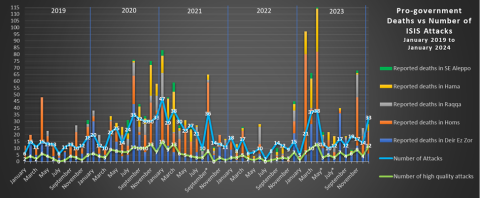
*Indicates attacks in Damascus City claimed by ISIS. Two additional IED attacks occurred in Homs City in June 2023 that went unclaimed but were suspected to be conducted by ISIS.
Confirmed ISIS attacks more than doubled in Homs (14), Raqqa (5), and Hama (5), increased in Deir Ez Zor (8), and remained steady in Aleppo (1).
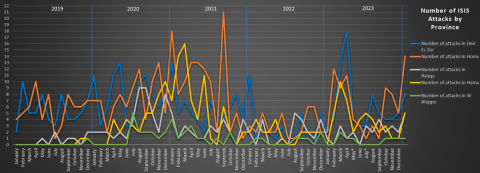
ISIS expanded its low-level insurgency within the urban belt of Deir Ez Zor in January. On January 1, ISIS attacked a position belonging to Iranian-backed forces northwest of the al-Ward Gas Field. On January 2, multiple cells launched a coordinated attack around Tabni, in west Deir Ez Zor. Militants captured the mobile network provider SyriaTel’s position outside the town, destroying the barracks and vehicles there, and ambushed responding soldiers with an Improvised Explosive Device (IED). Other ISIS militants cut the highway north of Tabni towards Ma’adan in Raqqa and shelled regime positions near Ma’adan. ISIS later claimed responsibility for the Tabni attack as part of its global campaign.
On January 6, locals reported the death of a regime security officer allegedly overseeing cross-river trade in Mayadeen. ISIS claimed responsibility for his murder two days later. This marked the third month in a row that ISIS assassinated a regime official in Mayadeen. On January 12, a second local was found executed in a village outside Mayadeen. ISIS again claimed responsibility, accusing the man of being a regime spy. On January 20, a third man working for regime security forces was assassinated inside Mayadeen.
ISIS cells were also foiled in two attacks in Deir Ez Zor this month. On January 16, a group of fighters attempting to attack a regime position near the Kharitah Oil Field fell into a minefield. One militant was wounded and captured by regime forces. On January 20, another cell attempted to attack regime forces in the Dweir countryside, but failed. One fighter was killed and one was captured.
On January 24, two local pro-regime fighters from the village of Kabajib disappeared while walking outside the village. Presumably executed by ISIS, their bodies were found on January 31.
In addition to the January 2 attack on Ma’adan, ISIS cells also conducted a number of attacks in the southeast of the governorate. On January 6, two members of the Military Intelligence were wounded by a mine on the Raqqa side of Jabal Bishri. On January 19, ISIS militants captured the hamlet of Zamleh Sharqi from regime forces and their tribal allies, killing two and wounding three. ISIS remained in control of the empty hamlet as of early February. That same day, another ISIS cell cut the road west of Resafa using a fake checkpoint. On January 21, clashes were reported north of the Zamleh Gas Field. According to journalist Zain al-Abidin, locals have also reported suspected ISIS sightings in the Dibsi Afnan region, west of Tabqa and in an area which has historically witnessed little to no ISIS activity.
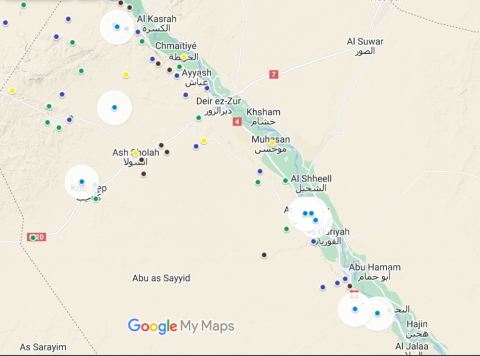
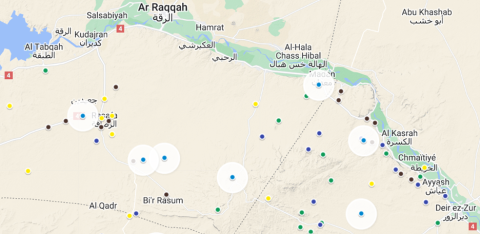
Map of locatable ISIS attacks (highlighted) in Dier Ez Zor (top) and Raqqa (bottom) in January 2024 alongside all other attacks in 2023.
Homs
ISIS activity in eastern Homs decreased in December, but remained focused around the Doubayat Oil Field, which the group had temporarily captured in November. January likewise saw most ISIS activity concentrated in this area, however, the group also expanded operations west into the desert just south of Palmyra and Arak.
On January 4, ISIS fighters attacked a group of shepherds southeast of Palmyra, killing one and kidnaping a young boy. The militants released the boy, who reportedly informed local security forces. Later that day, ISIS fighters ambushed the responding units combing the area, killing two and capturing their truck. ISIS claimed responsibility for the second attack. On January 5, ISIS ambushed a regime patrol near the Abyad Dam, north of Palmyra, killing at least one soldier and again claiming responsibility for the attack.
On January 6, ISIS launched three coordinated attacks across the east Homs front, initiated a new short offensive. The attacks targeted regime positions in the Sukhnah countryside, the Abbasiyah area south of Palmyra, and Wadi Abyad north of Palmyra. Intermittent clashes also took place south of Arak between January 6 and January 9, but ISIS forces were ultimately repelled. Seven militants were captured and were later reportedly executed by pro-regime forces.
On January 8, ISIS killed one and wounded two regime fighters in an ambush on their vehicle near Tuwaynan, in northeast Homs. The next day, the group conducted an IED ambush of a military bus on the T3-Palmyra road, killing 10 and wounding 23. Both attacks were later claimed by the group. On January 10, ISIS cells reportedly advanced into the no-man’s land east of al-Kawm. However, these probes were ultimately repelled, thanks to the intervention of Russia fighter jets over the following days.
On January 19, ISIS cells advanced on regime positions south of Palmyra, seizing five outposts east of the Talilah Preserve (bordering the aforementioned Abbasiyah area) from Iranian-backed forces. IRGC-backed foreign fighters were able to stall the ISIS advance on January 20, but between 10 and 16 Liwa Zainebiyoun members were killed or injured in the fighting. On January 21, clashes were reported near the village of Taybeh, north of Sukhnah.
Lastly, on January 7, security forces identified and dismantled an IED inside the Akrama neighborhood of Homs. This action followed multiple IED attacks inside Homs City in late 2023, all likely conducted by ISIS cells that had infiltrated the city.
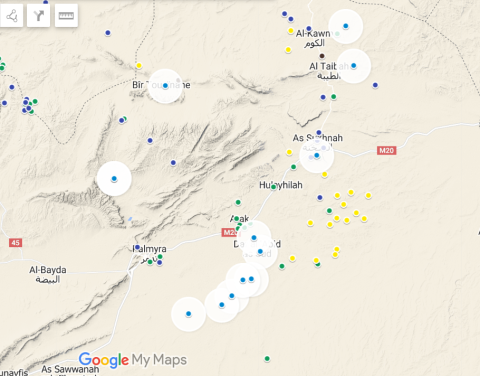
Map of locatable ISIS attacks in Homs (highlighted) in January 2024 alongside all other attacks in 2023.
Hama and Aleppo
Significant ISIS activity returned to east Hama in January. On January 9, four Syrian Hezbollah fighters, including a commander, were killed by an IED while driving near Ithriya. Civilians were also wounded by mines on January 13 and January 18 in the east Salamiyah countryside. On January 20, an ISIS cell raided a small Bedoiun village in the east Hama desert, killing a child and wounding another, burning down six tents and three vehicles, killing more than 200 sheep and stealing hundreds more.
Nearby, another group of Hezbollah-affiliated Syrian fighters were ambushed shortly after deploying to the southern Aleppo region just north of Ithriya, leaving three dead.
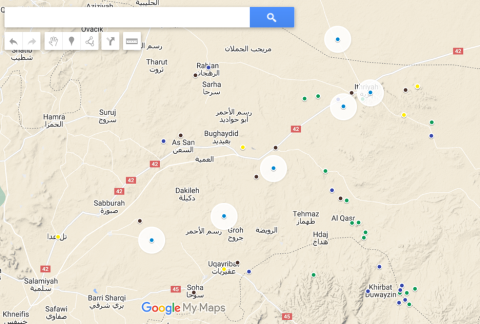
Map of locatable ISIS attacks in Hama and Aleppo (highlighted) in January 2024 alongside all other attacks in 2023.
Looking Ahead
ISIS’s latest offensive began with the November capture of the Doubayat Gas Field, and continued even after the militants were expelled in early December. The first three weeks of January demonstrated the group’s determination to expand operations in a significant and sustained manner. However, the ability to effectively utilize Syrian and Russian air power in central Syria this month has, once again, stymied ISIS’s operations. As this author has repeatedly observed, effective and consistent use of air power was the key for the regime and its allies to roll back ISIS’s gains at the start of 2021. It was the deep reduction of this air campaign in 2022 and 2023 that gave ISIS the room to re-engage in 2020-style operations. As long as Damascus and Moscow are able to keep up the bombing and intelligence, surveillance, and reconnaissance (ISR) drone campaign, they should be able to prevent the type of widespread ISIS operations that resulted in captured regime positions and coordinated multi-day assaults.
There are other significantly worrying trends, however. ISIS’s continually widening insurgency inside the Deir Ez Zor urban belt and clear return/reactivation in eastern Hama are both key footholds the group can use to expand and deepen its financial and smuggling operations.
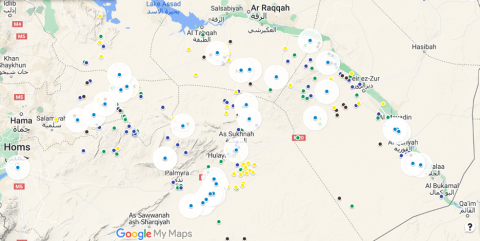
Map of locatable ISIS attacks (highlighted) in January 2024 alongside all other attacks in 2023. To view an interactive version of this map, please click here.
*High quality attacks are defined as attacks behind frontlines, those that result in seized positions, target regime officers, involve coordinated attacks on multiple positions, fake checkpoints, ambushes on military convoys, or attacks on checkpoints that kill at least three soldiers or lead to POWs.
Stay up to date on our latest news.
Get the latest news on extremism and counter-extremism delivered to your inbox.